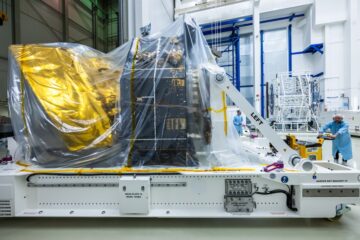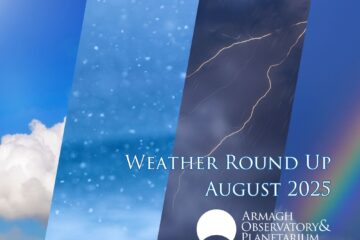In a paper entitled ‘GALEX J184559.8−413827: a new extreme helium star identified using SALT’, Armagh astronomer Simon Jeffery reports the first new extreme helium star to be discovered in nearly 40 years.
Extreme helium stars represent a small group of low-mass supergiant stars. They have spectral types equivalent to A and B, but with very weak or absent hydrogen lines and strong helium lines. First recognised in the 1940’s, their number grew to around 17 by the early 1980’s, with most discovered from low-resolution spectroscopic surveys of “faint” blue stars. There are strong links between extreme helium stars and the cooler and very variable R Coronae Borealis stars; the most promising explanation for the extraordinary surface composition of both groups is that they were formed from the merger of two white dwarfs – a rare event that would have produced a strong burst of gravitational waves in the Galaxy.
Up to the 1970s, “faint” meant 13th magnitude. Most extreme helium stars are sufficiently luminous that to have an apparent magnitude greater than 14 would place them beyond our own Galaxy. Therefore it is not surprising that subsequent surveys of faint blue stars discovered no new extreme helium stars. What these surveys have found, in abundance, are hot subdwarfs, the majority of which are hydrogen-rich. Hot subdwarfs have surfaces which are between four and ten times hotter, and diameters five times smaller than the Sun. Some 10 per cent show strong helium and weak or absent hydrogen lines. Most lie close to the helium-main sequence, with ionised helium lines prominent in the spectrum. It is suspected that these are also the product of mergers between two white dwarfs – and more gravitational waves.

The primary mirror matrix of the Southern Africa Large Telescope. Each hexagonal element has a diameter of 1 meter (photo: Simon Jeffery).
Simon Jeffery is carrying out a survey of helium-rich subdwarfs with the High-Resolution Spectrograph on the Southern Africa Large Telescope, in which the Armagh Observatory and Planetarium is a stakeholding partner.
Helium-rich hot subdwarfs can be recognized from two distinctive sets of lines in their spectra (where their light is dispersed like a rainbow). Helium atoms with two electrons (and therefore neutral) are seen in cooler subdwarfs; helium atoms with only one electron (and hence ionized) are seen in hotter subdwarfs, with some overlap between the two groups. The spectrum of one star, GALEX J184559.8-413827 stood out from the sample, having a forest of lines due to nitrogen. Overfamiliarity with the spectrum of another star, the pulsating helium star V652 Herculis, triggered an instant recognition that J1845 might not be a hot subdwarf but, rather, a new low-luminosity extreme helium star, the first to be found for nearly 40 years.

Part of the SALT HRS spectrum of J1845−4138 (black) compared with the spectrum of V652 Her (red) (from Jeffery 2017, MNRAS 470, 3557).
J1845 is spectroscopically similar to V652 Herculis, one of a handful of low-luminosity extreme helium stars which has been studied by Jeffery in great detail, and whose decreasing pulsation period and surface chemistry point to an origin in a helium white dwarf merger. The strong nitrogen spectrum is almost certainly related to the nuclear history of the star; in stars, hydrogen is converted to helium through a catalytic process involving a sequence of reactions of hydrogen atoms with carbon, nitrogen and oxygen. This ultimately produces one helium atom for every four hydrogen atoms destroyed; at the same time most of the original carbon and oxygen is converted to nitrogen, the key element in the process. This processed helium is revealed following the merger of two white dwarfs, when helium from the centre of a white dwarf destroyed in the merger is exposed on the surface of the new star. The discovery of J1845 adds substantial evidence for a sequence of post-merger stars evolving to become extremely helium-rich subdwarfs. The discovery was published in 2017 September in the Monthly Notices of the Royal Astronomical Society, Volume 470, p.3557.
Article by: Simon Jeffery, Research Astronomer at Armagh Observatory and Planetarium



1 Comment
Discovery of the first new extreme helium star for 40 years – MeasurementDataBases for Industry & Science · November 24, 2017 at 09:58
[…] Astronotes Astronotes: In a paper entitled ‘GALEX J184559.8−413827: a new extreme helium star identified […]